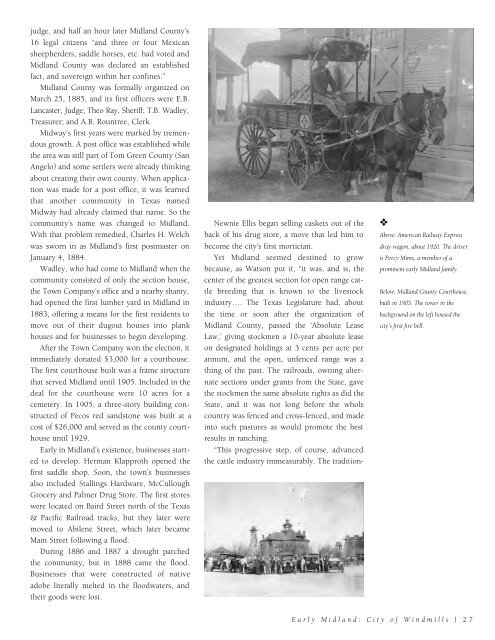Historic Midland
An illustrated history of the Midland County area, paired with the histories of companies, families and organizations that make the region great.
An illustrated history of the Midland County area, paired with the histories of companies, families and organizations that make the region great.
You also want an ePaper? Increase the reach of your titles
YUMPU automatically turns print PDFs into web optimized ePapers that Google loves.
judge, and half an hour later <strong>Midland</strong> County’s<br />
16 legal citizens “and three or four Mexican<br />
sheepherders, saddle horses, etc. had voted and<br />
<strong>Midland</strong> County was declared an established<br />
fact, and sovereign within her confines.”<br />
<strong>Midland</strong> County was formally organized on<br />
March 25, 1885, and its first officers were E.B.<br />
Lancaster, Judge; Theo Ray, Sheriff; T.B. Wadley,<br />
Treasurer; and A.B. Rountree, Clerk.<br />
Midway’s first years were marked by tremendous<br />
growth. A post office was established while<br />
the area was still part of Tom Green County (San<br />
Angelo) and some settlers were already thinking<br />
about creating their own county. When application<br />
was made for a post office, it was learned<br />
that another community in Texas named<br />
Midway had already claimed that name. So the<br />
community’s name was changed to <strong>Midland</strong>.<br />
With that problem remedied, Charles H. Welch<br />
was sworn in as <strong>Midland</strong>’s first postmaster on<br />
January 4, 1884.<br />
Wadley, who had come to <strong>Midland</strong> when the<br />
community consisted of only the section house,<br />
the Town Company’s office and a nearby shanty,<br />
had opened the first lumber yard in <strong>Midland</strong> in<br />
1883, offering a means for the first residents to<br />
move out of their dugout houses into plank<br />
houses and for businesses to begin developing.<br />
After the Town Company won the election, it<br />
immediately donated $3,000 for a courthouse.<br />
The first courthouse built was a frame structure<br />
that served <strong>Midland</strong> until 1905. Included in the<br />
deal for the courthouse were 10 acres for a<br />
cemetery. In 1905, a three-story building constructed<br />
of Pecos red sandstone was built at a<br />
cost of $26,000 and served as the county courthouse<br />
until 1929.<br />
Early in <strong>Midland</strong>’s existence, businesses started<br />
to develop. Herman Klapproth opened the<br />
first saddle shop. Soon, the town’s businesses<br />
also included Stallings Hardware, McCullough<br />
Grocery and Palmer Drug Store. The first stores<br />
were located on Baird Street north of the Texas<br />
& Pacific Railroad tracks, but they later were<br />
moved to Abilene Street, which later became<br />
Main Street following a flood.<br />
During 1886 and 1887 a drought parched<br />
the community, but in 1888 came the flood.<br />
Businesses that were constructed of native<br />
adobe literally melted in the floodwaters, and<br />
their goods were lost.<br />
Newnie Ellis began selling caskets out of the<br />
back of his drug store, a move that led him to<br />
become the city’s first mortician.<br />
Yet <strong>Midland</strong> seemed destined to grow<br />
because, as Watson put it, “it was, and is, the<br />
center of the greatest section for open range cattle<br />
breeding that is known to the livestock<br />
industry…. The Texas Legislature had, about<br />
the time or soon after the organization of<br />
<strong>Midland</strong> County, passed the ‘Absolute Lease<br />
Law,’ giving stockmen a 10-year absolute lease<br />
on designated holdings at 3 cents per acre per<br />
annum, and the open, unfenced range was a<br />
thing of the past. The railroads, owning alternate<br />
sections under grants from the State, gave<br />
the stockmen the same absolute rights as did the<br />
State, and it was not long before the whole<br />
country was fenced and cross-fenced, and made<br />
into such pastures as would promote the best<br />
results in ranching.<br />
“This progressive step, of course, advanced<br />
the cattle industry immeasurably. The tradition-<br />
❖<br />
Above: American Railway Express<br />
dray wagon, about 1920. The driver<br />
is Percy Mims, a member of a<br />
prominent early <strong>Midland</strong> family.<br />
Below: <strong>Midland</strong> County Courthouse,<br />
built in 1905. The tower in the<br />
background on the left housed the<br />
city’s first fire bell.<br />
Early <strong>Midland</strong>: City of Windmills | 27
















